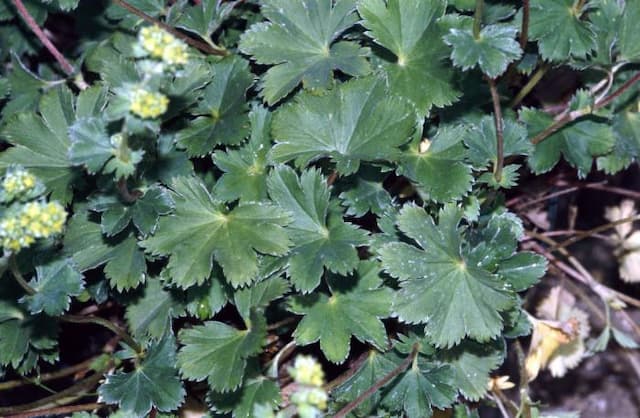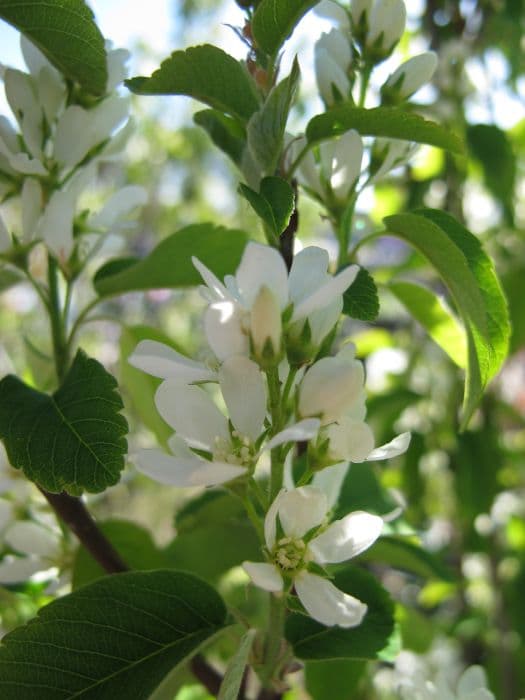Lady Banks' Rose Rosa banksiae 'Lutea' (Ra/d)

ABOUT
The Lady Banks' Rose, specifically the 'Lutea' variety, is a charming and visually striking plant. It's distinguished by its clusters of small yellow flowers that typically bloom in the spring. The double flowers, which look like tiny rosettes, are rich in a golden-yellow hue and are densely packed together, creating a delightful impact when the plant is in full bloom. These blossoms are also known for their faint, delicate scent, which adds an additional layer of appeal to the plant. In terms of foliage, the Lady Banks' Rose has smooth, glossy leaves that remain evergreen in more temperate regions. The leaves are a fresh, deep green color and are made up of smaller leaflets that give the plant a somewhat lighter, feathered texture. Because of this consistent foliage, the plant maintains its presence and provides a background of green, which makes the yellow flowers stand out even more when they emerge. The canes or stems of the Lady Banks' Rose are quite slender and flexible, often lending themselves to being trained along fences or over structures such as arbors, trellises, or pergolas. In the absence of support, the plant can sprawl over the ground almost as a ground cover, blanketing the area with its foliage and flowers. The overall appearance is one of abundance and vibrancy, making the Lady Banks' Rose ('Lutea') a favorite among garden enthusiasts who seek to add a splash of color and romantic, old-fashioned charm to their landscape.
About this plant
 Names
NamesFamily
Rosaceae.
Synonyms
Lady Banks' Rose, Banks' Rose, Yellow Lady Banks Rose.
Common names
Rosa banksiae 'Lutea'
 Toxicity
ToxicityTo humans
The Lady Banks' rose generally is not considered toxic to humans. Ingesting any part of this rose is unlikely to cause poisoning or resultant symptoms. However, as with any plant material, it can potentially cause mild stomach upset if ingested in large quantities or allergic reactions in sensitive individuals.
To pets
The Lady Banks' rose is not known to be toxic to pets either. It is not listed as a toxic plant for animals such as dogs or cats. Nevertheless, ingestion of substantial amounts of the plant might lead to gastrointestinal upset such as vomiting or diarrhea in pets, more likely due to the physical irritation of plant matter rather than chemical toxicity.
 Characteristics
CharacteristicsLife cycle
Perennials
Foliage type
Semi-deciduous
Color of leaves
Green
Flower color
Yellow
Height
15-20 feet (4.5-6 meters)
Spread
15-20 feet (4.5-6 meters)
Plant type
Climber
Hardiness zones
6
Native area
China
Benefits
 General Benefits
General Benefits- Ornamental Value: 'Lutea' adds aesthetic appeal with its abundant light yellow flowers that cover the plant in springtime.
- Low Maintenance: It is known for being relatively easy to care for, requiring minimal maintenance once established.
- Drought Tolerance: Once established, this variety of Lady Banks' rose can handle periods of drought, making it suitable for xeriscaping.
- Rapid Growth: It grows quickly, providing a fast cover for trellises, arbors, fences, and other structures.
- Thornless: Unlike many roses, Lady Banks' is thornless, making it more user-friendly for gardeners during planting and maintenance.
- Long Lifespan: It is a tough, long-lived plant that can thrive for many years with proper care.
- Attracts Pollinators: The flowers attract beneficial pollinators such as bees and butterflies, supporting local ecosystems.
- Tolerates Different Soils: It can grow in a variety of soil types, though it prefers well-drained soils.
- Disease Resistance: This rose variety tends to be more resistant to common rose diseases, such as rose rust and black spot.
- Privacy Screening: Due to its dense growth, it can be used as a living screen, providing privacy and reducing noise pollution.
 Medical Properties
Medical PropertiesThis plant is not used for medical purposes.
 Air-purifying Qualities
Air-purifying QualitiesThis plant is not specifically known for air purifying qualities.
 Other Uses
Other Uses- Rosa banksiae 'Lutea', commonly referred to as Lady Banks' rose, can be used to create natural fencing or living walls, providing privacy with its dense growth habit and climbing ability.
- The long, flexible canes of Lady Banks' rose are sometimes used in crafting or as natural weaving materials to create baskets, wreaths, and other decorative items.
- This variety of rose can be trained to grow over arbors or pergolas, offering aesthetically pleasing shade structures in gardens and parks.
- With its abundant and vibrant yellow blossoms, Lady Banks' rose is excellent for floral displays and can be cut for table arrangements or large installations.
- The dense foliage of Lady Banks' rose can be a habitat for beneficial insects, offering shelter for pollinators such as bees and butterflies.
- Some gardeners use the thornless nature of Lady Banks' rose to create safe play areas for children, where they can engage with nature without the risk of being pricked.
- Lady Banks' rose can be used in perfumery for creating rose water or natural fragrances, albeit less commonly than other fragrant roses.
- The plant can contribute to soil stabilization when planted on banks or slopes, thanks to its extensive root system that helps prevent erosion.
- Incorporating Lady Banks' rose in a themed garden, such as a Victorian or cottage garden, can enhance the historical authenticity and visual appeal of the landscape design.
- During the flowering season, the petals of Lady Banks' rose can be used to create natural confetti for celebrations such as weddings or spring festivals.
Interesting Facts
 Feng Shui
Feng ShuiThe Lady Banks' rose is not used in Feng Shui practice.
 Zodiac Sign Compitability
Zodiac Sign CompitabilityThe Lady Banks' rose is not used in astrology practice.
 Plant Symbolism
Plant Symbolism- Pure Love - The Rosa banksiae 'Lutea', often known as Lady Banks' Rose, symbolizes pure and untainted love, as roses often represent love in various forms and this variety, with its non-thorny stems, suggests a love without pain or hardship.
- Beauty and Grace - Lady Banks' Rose, with its delicate yellow flowers, is commonly associated with beauty and grace, reflecting the charm and elegance of the bloom.
- Renewal and Prosperity - The prolific blooming nature of this plant, especially in spring, points to themes of renewal and the ushering in of prosperity through its vibrant and abundant presence in the garden.
- Eternal Bonds - As a climbing rose known for its vigor and persistence, it represents strong, ever-growing relationships and everlasting connections between people.
- Friendship - The warm, yellow color of the flowers is often associated with friendship and caring, making it a suitable plant to symbolize bonds of platonic affection.
 Water
WaterFor the Lady Banks' rose, watering should be thorough and deep, typically needing about 1 to 2 inches of water per week. During the growing season, water the plant once or twice a week, depending on rainfall and soil drainage. In the absence of rainfall, provide the equivalent of 1 gallon of water per square foot every week. During periods of extreme heat or drought, increase watering frequency to maintain soil moisture, but avoid overwatering, which can lead to root rot. Always water at the base of the plant to minimize wetting the foliage, which can promote disease.
 Light
LightThe Lady Banks' rose thrives in full sun to partial shade. The best spot for this plant is a location where it receives at least 6 hours of direct sunlight daily. While it can tolerate partial shade, flowering is most prolific when the plant is placed in an area with ample sunlight. Avoid deep shade, as this can result in sparse blooming and a leggy growth habit.
 Temperature
TemperatureLady Banks' rose is hardy and can tolerate a range of temperatures, but it performs best when the temperature is between 60°F and 75°F. The plant can survive minimum temperatures as low as 10°F, making it suitable for USDA zones 6 through 9. It can handle summer highs up to 95°F, but ensure it receives ample water during these warmer periods to prevent stress.
 Pruning
PruningPruning the Lady Banks' rose helps to maintain its shape, remove dead wood, and encourage vigorous growth and flowering. Prune immediately after flowering since it blooms on the previous year's growth. Thin out older canes to rejuvenate the plant, and remove any dead, diseased, or crossing branches. The best time for pruning is in the late spring or early summer, after the blooms have faded.
 Cleaning
CleaningAs needed
 Soil
SoilLady Banks' Rose thrives in well-draining soil with a mix of two parts loam, one part peat moss, and one part sand or perlite. The ideal soil pH for Rosa banksiae 'Lutea' is between 6.0 and 7.0, slightly acidic to neutral. Amend the soil with organic matter to provide nutrients and improve texture.
 Repotting
RepottingLady Banks' Rose typically does not require frequent repotting as it is often grown outdoors and can spread its roots. However, if grown in containers, repotting may be necessary every 2 to 3 years to refresh the soil and accommodate root growth.
 Humidity & Misting
Humidity & MistingLady Banks' Rose is tolerant of a wide range of humidity levels; however, it prefers average outdoor humidity conditions. There's no need for specific humidity adjustments when growing this plant outdoors.
 Suitable locations
Suitable locationsIndoor
Ensure bright light, limit growth, prune often.
Outdoor
Full sun, well-drained soil, protect in winter.
Hardiness zone
6-9 USDA
 Life cycle
Life cycleThe Lady Banks' rose (Rosa banksiae 'Lutea') begins its life as a seed, which, upon germinating, develops into a seedling with its first true leaves. As it grows, it enters the vegetative stage where it forms a sturdy root system and branching stems. Upon reaching maturity, typically in a few years, it enters the flowering stage annually in spring, displaying numerous small, double, lightly fragrant, pale yellow flowers. After pollination, it produces hips (fruit) that contain seeds for dissemination. The plant then goes through a period of dormancy in the winter, when it conserves energy for the next growth cycle. With proper care and conducive conditions, the Lady Banks' rose can live for many years, often growing vigorously and covering arbors, walls, or fences with its sprawling habit.
 Propogation
PropogationPropogation time
Spring-Early Summer
The most popular method of propagating the Lady Banks' rose, Rosa banksiae 'Lutea', is through semi-hardwood cuttings. This technique is typically performed in late summer when the current season's growth has started to mature but is not yet fully hardwood. A 4 to 6 inch cutting should be taken, ensuring that it includes at least two to three sets of leaves. The lower leaves are removed and the cut end is often dipped in a rooting hormone to encourage root development. The cutting should then be placed in well-draining soil, kept moist, and protected from direct sunlight until roots have established, which can take several weeks to a few months. During this time, it is crucial to maintain a stable environment to avoid shock to the cuttings, which could impede root formation.









